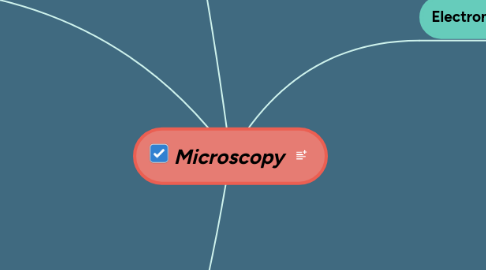
1. Type of microscope
1.1. Light microscope
1.1.1. Simple light microscope
1.1.2. Compound light microscope
1.2. Dark field microscope
1.3. Fluorescence microscope
1.4. Phase contrast microscope
1.5. Electron microscope
2. Characteristics of microscope
2.1. Light microscope
2.1.1. Mag ~ 1000-1500x
2.1.2. Best resolution 0.2 μm
2.1.3. Radiation source : visible light
2.1.4. Medium of travel : air
2.1.5. Glass lens
2.2. Electron microscope
2.2.1. Mag over 100,000
2.2.2. Best resolution 0.5 nm for TEM, 2-3 nm for SEM
2.2.3. Medium of travel : high vacuum
2.2.4. Radiation source : electron beam
2.2.5. Electromagnetic lens
3. Magnification and resolution
3.1. Magnification = I/O
3.1.1. I = image distance
3.1.2. O = object distance
3.2. Total magnification
3.2.1. = Mag of ocular(Mo) * Mag of objective(Mi)
3.2.2. For electron microscope = Mo * Mi * Mp
3.3. Useful magnification
3.3.1. Resolution of human eye/ resolution of lens system
3.4. Resolution(r)
3.4.1. = 0.612 λ/(n (sin α))
3.4.1.1. 0.612 = a constance
3.4.1.2. λ = wavelength of illumination
3.4.1.3. n = refractive index
3.4.1.4. α = aperture angle of the lens
4. Electron microscope
4.1. Basic principle
4.1.1. Electron gun
4.1.1.1. A beam of high velocity negatively charged electrons.
4.1.1.2. Thin Filament made of tungsten
4.1.2. Electromagnetic lens
4.1.2.1. Focus the beam of electrons on the specimen
4.1.2.2. Electrons can be affected by magnetic field
4.1.3. Electron-Specimen Interactions
4.1.3.1. Reflected electron —> SEM
4.1.3.1.1. Secondary electron
4.1.3.1.2. electron excites an electron in the sample
4.1.3.1.3. Low energy
4.1.3.1.4. Topography related
4.1.3.2. Transmitted electron —> TEM
4.1.3.2.1. Unscattered Electrons (Transmitted beam)
4.1.3.2.2. Very thin specimen (<200 nm)
4.2. Specimen preparation
4.2.1. TEM
4.2.1.1. Acquisition
4.2.1.2. Fixation
4.2.1.2.1. Glutaraldehyde: Cross-link protein (primary fixation)
4.2.1.2.2. Osmium Tetroxide: Reacting with lipid molecule, effective in scattering electron, mordant for lead staining (secondary fixation)
4.2.1.3. Eliminates any free unreacted chemicals
4.2.1.4. Dehydration by EtOH or acetone
4.2.1.5. Replacement of the dehydration solution by propylene oxide
4.2.1.6. Dehydrants are replaced by resin monomer
4.2.1.7. Embedding and Curing
4.2.2. SEM
4.2.2.1. Acquisition
4.2.2.2. Fixation : similar to ones used for TEM
4.2.2.3. Dehydration
4.2.2.3.1. Critical Point Drying
4.2.2.3.2. Freeze-Drying
4.2.2.3.3. Air-Drying
4.2.2.4. Drying and mounting on stub
4.2.2.5. Coating with conductive metal
4.2.2.5.1. Positive staining
4.2.2.5.2. Negative staining
4.2.2.5.3. Metal shadowing
